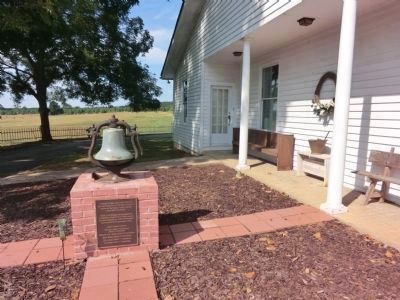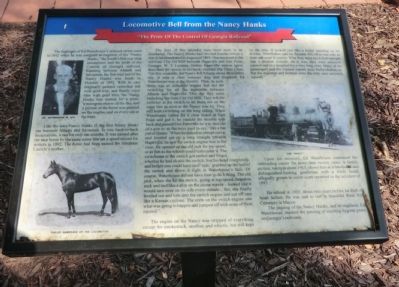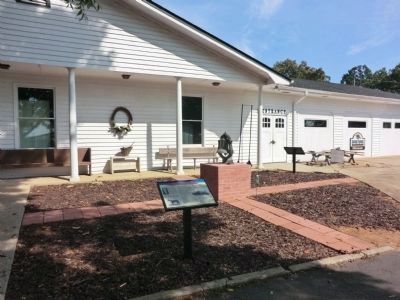Hampton in Henry County, Georgia — The American South (South Atlantic)
Locomotive Bell from the Nancy Hanks
"The Pride Of The Central Of Georgia Railroad"
Like the later Nancy Hanks II, the first Nancy Hanks ran between Atlanta and Savannah. In two back-to-back incarnations, it ran for only ten months. It was named after the race horse by the same name that set a speed record for trotters in 1892. The horse had been named for Abraham Lincoln’s mother.
The days of this splendid train were soon to be numbered. The Nancy Hanks had two bad wrecks before it was to be abandoned in August of 1893. One occurred at the old Gate City Oil Mill between Hapeville and East Point, Georgia. E.T. Landers, former Hapeville station agent, described the wreck in his book, entitled the Choo Choo. “On this occasion, the Nancy left Atlanta about 40 minutes late. It was a clear summer day, and Engineer Ed Waterhouse was at the throttle. Then, as now, there was an industrial engine that did the switching for all the industries between Atlanta and Hapeville. This day they left the switcher at the switch to let them out on the main line as soon as the Nancy was by. They still kept switching on the long siding. When Waterhouse called for a clear board at East Point and got it, he yanked the throttle way back and passed East Point like he was shot out of a gun or, s the boys used to say, ‘like a bat out of Hades.’ When he turned an abrupt curve, and leveled out on a long straight towards Hapeville, he saw the switch engine was in the clear. He opened up the old jack for top speed, or as fast as the wheels could turn under it. The switchman at the switch got rattled and forgot whether he had closed the switch, lost his head completely, and before you could had said ‘scat,’ grabbed up the ball of the switch and threw it right in Waterhouse’s face. Of course, Waterhouse did not have time to do a thing. The old jack, when she hit the switch, going at top speed, began to rock and reel like a ship on the ocean waves—looked like it would turn over on its side every minute—but, she finally leveled out and tore into the switch engine and cut off cars like a Kansas cyclone. The crew on the switch engine saw what was going to happen and jumped off with none of them injured.”
The engine on the Nancy was stripped of everything except the smokestack, sandbar, and whistle, but still kept on the rails. It looked just like a boiler standing on its drivers. Waterhouse and his fireman fell off to one side as their cab went to pieces. Why they were not killed outright was a modern miracle. As it was, they were seriously injured and in a hospital for a very long time. Many of the passengers and the express master were badly shaken up, but the engineer and fireman were the only ones seriously injured.”
Upon his recovery, Ed Waterhouse continued his railroading career for more than twenty years. A family picture, taken in about 1915, show him as a handsome and distinguished-looking gentleman with a white beard, allegedly grown to cover scars received in the accident of 1893.
He retired in 1915, about two years before he died of heart failure. He was laid to rest in beautiful Rose Hill Cemetery in Macon.
The passing of the Nancy Hanks, and its engineer, Ed Waterhouse, marked the passing of exciting bygone years on Georgia’s railroads.
(captions)
(upper left) Ed Waterhouse in 1915
(lower left) Fabled namesake of the locomotive
(lower right) The “Nancy”
Topics and series. This historical marker is listed in this topic list: Railroads & Streetcars.

Photographed By Don Morfe, September 20, 2013
3. Locomotive Bell from the Nancy Hanks
"Although the battle sounds at the Nash Farm have been silenced for over 140 years, a conflict of another sort has raged, the conflict between preservation and progress."
Thanks to the foresight and determination of Commissioner Elizabeth "B.J." Mathis, who led her fellow commissioners, Nash Farm Battlefield has been preserved for generations to come.
Thanks to the foresight and determination of Commissioner Elizabeth "B.J." Mathis, who led her fellow commissioners, Nash Farm Battlefield has been preserved for generations to come.
Location. 33° 27.516′ N, 84° 17.436′ W. Marker is in Hampton, Georgia, in Henry County. Marker can be reached from the intersection of Jonesboro Road and Babbs Mill Road, on the left when traveling south. The marker is located at the Nash Farm Battlefield Park. Touch for map. Marker is at or near this postal address: 4361 Jonesboro Rd, Hampton GA 30228, United States of America. Touch for directions.
Other nearby markers. At least 8 other markers are within 3 miles of this marker, measured as the crow flies. "The Old Bronze Gentleman of Lovejoy's Station" (within shouting distance of this marker); The "Right Flank" on the McDonough Road (within shouting distance of this marker); Kilpatrick's Raid at the Nash Farm (within shouting distance of this marker); Kilpatrick's Raid (about 300 feet away, measured in a direct line); The Crawford-Dorsey House (approx. 1.3 miles away); Cavalry Action at Lovejoy's Station (approx. 2.1 miles away); Constantine Memorial (approx. 2½ miles away); Georgia Militia at Lovejoy's Station (approx. 2.6 miles away). Touch for a list and map of all markers in Hampton.
Credits. This page was last revised on February 1, 2021. It was originally submitted on November 11, 2013, by Don Morfe of Baltimore, Maryland. This page has been viewed 852 times since then and 23 times this year. Last updated on June 11, 2016, by Luke Landers of Dothan, Alabama. Photos: 1, 2, 3. submitted on November 11, 2013, by Don Morfe of Baltimore, Maryland. • Bernard Fisher was the editor who published this page.

